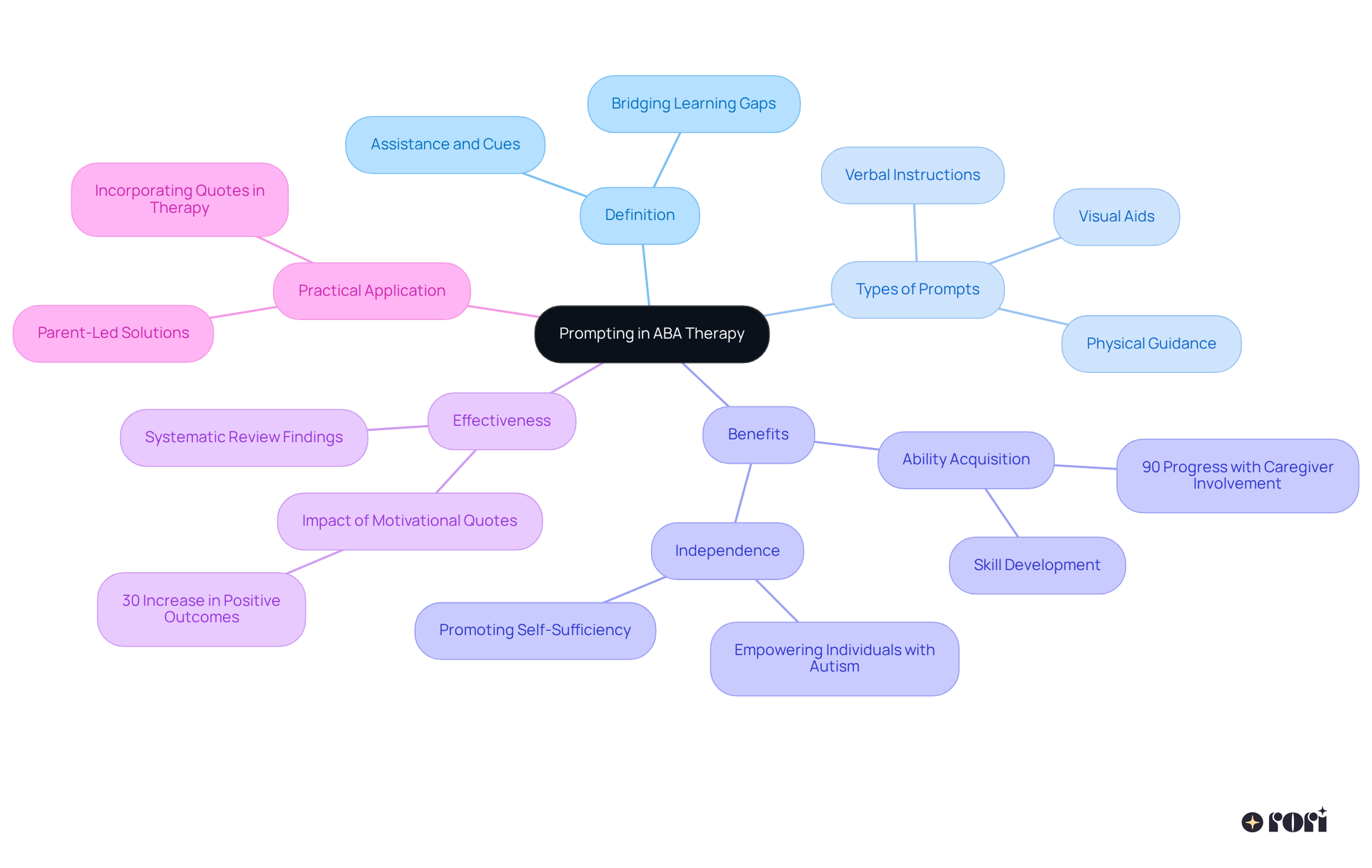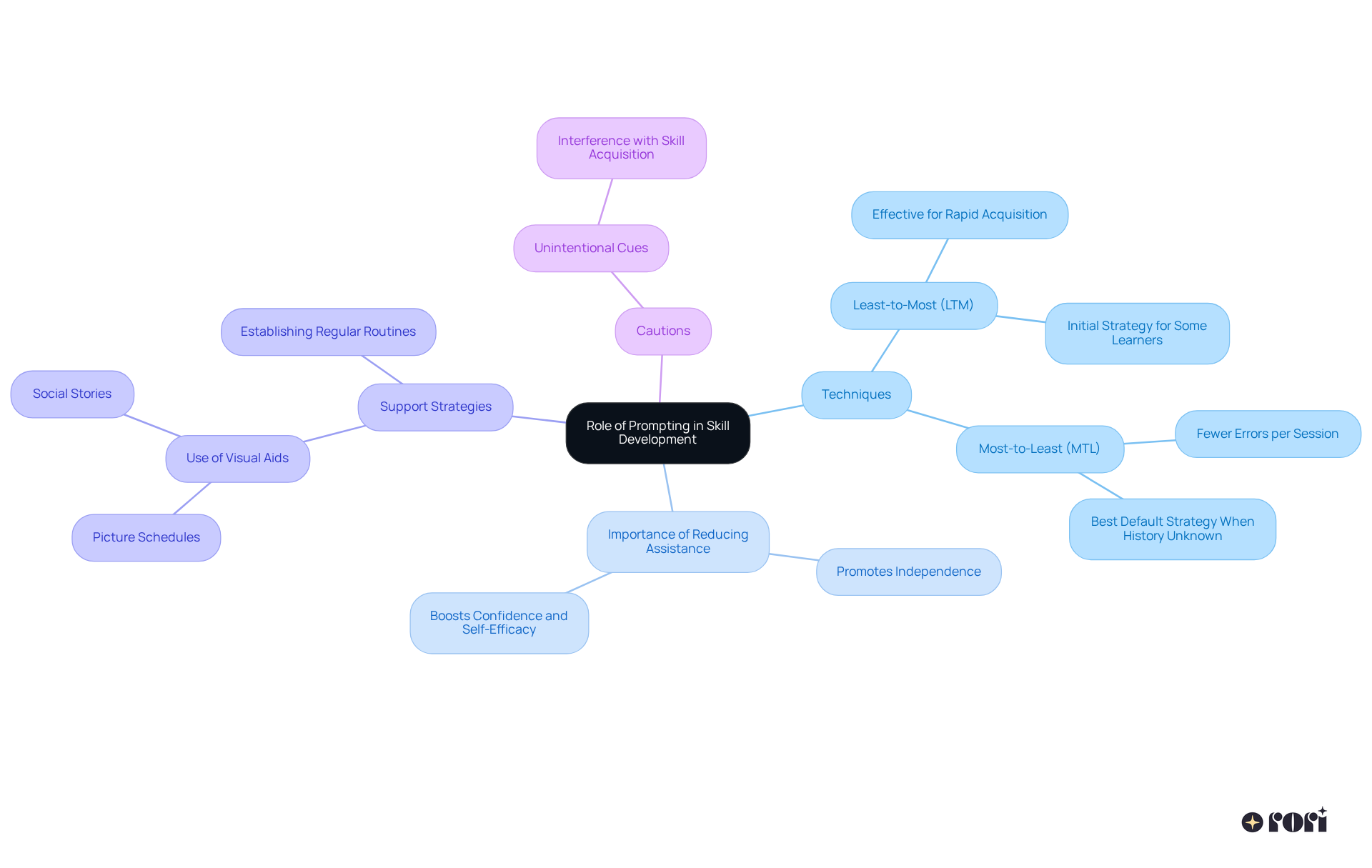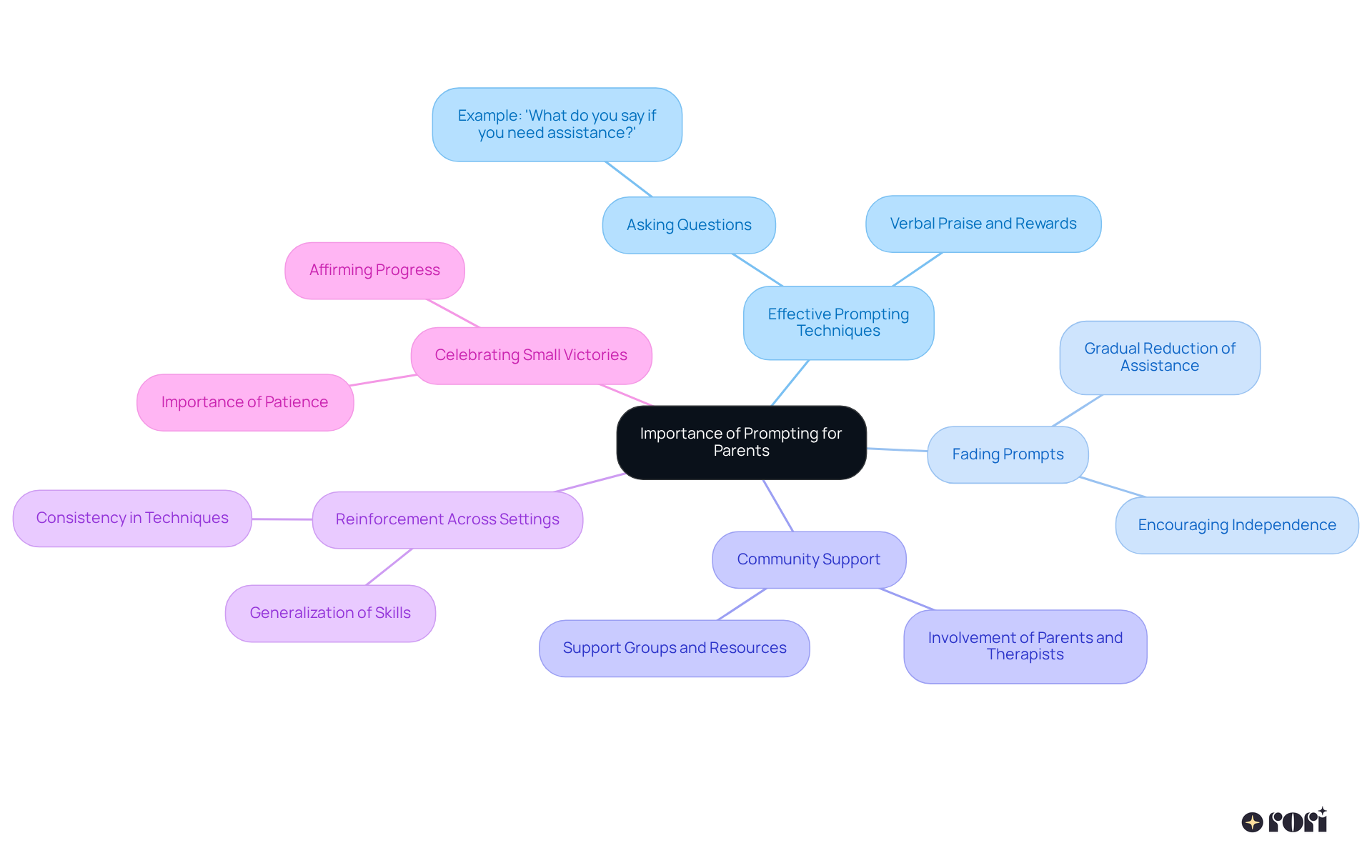This article dives into the concept of prompting in Applied Behavior Analysis (ABA) therapy and highlights its essential role in child development, especially for children with autism. Prompting involves providing helpful cues—like verbal, gestural, and visual aids—that support children in learning new skills and gaining independence. Research shows that when these methods are used effectively, children can make significant progress.
So, what does this mean for parents? Well, think of prompting as a gentle nudge in the right direction. Imagine your child learning to tie their shoes or say 'hello' to a friend. With the right prompts, these tasks become much more manageable! It's all about creating those supportive moments that help our little ones thrive.
If you’re feeling overwhelmed, remember you’re not alone. Many parents face similar challenges, and seeking help is a great step forward. Let’s explore this together! We’re here to help you every step of the way!
Understanding the nuances of prompting in Applied Behavior Analysis (ABA) therapy can be a powerful tool for fostering child development! This approach not only helps children acquire new skills but also promotes independence, especially for those with developmental delays. As caregivers and educators explore the various types of prompts—from verbal cues to visual aids—they might wonder: how can these strategies be tailored to meet the unique needs of each child?
Diving into the intricacies of prompting offers valuable insights into enhancing educational outcomes. It’s all about supporting our little ones on their journey toward greater autonomy. Let’s explore this together and see how we can make a difference in their lives!
The concept of prompting definition ABA in therapy is centered around providing the right assistance or cues to encourage specific responses or behaviors from young individuals. This method is essential for enhancing learning, as it helps bridge the gap between what a young person can currently do and what they aim to achieve. There are various forms of prompts—like verbal instructions, physical guidance, and visual aids—that support young individuals in completing tasks until they can do it on their own.
Research shows that prompting methods significantly boost ability acquisition, especially for youth with developmental delays. In fact, studies reveal that 90% of individuals show remarkable progress when therapy hours are properly implemented with active caregiver involvement. Isn’t that encouraging?
But prompting isn’t just about helping kids acquire abilities; it also plays a vital role in promoting independence, especially for children with autism. For example, a systematic review of fourteen studies published across nine different journals highlighted how effective prompting methods are in teaching cognitive, social, emotional, and language skills to preschoolers with developmental delays. These findings really emphasize the importance of tailored prompting definition aba strategies in ABA therapy, which support individual strengths while helping kids learn new behaviors.
Incorporating motivational quotes into therapy sessions can make prompting even more effective. Clients who experience positive reinforcement see a 30% increase in favorable behavioral outcomes, showing just how impactful encouragement can be in the learning process. At Rori Behavioral Innovations Inc., we employ highly trained, licensed, and insured professionals in autism care, ensuring that your youth receives the best support possible.
Ultimately, the goal of prompting is to empower individuals with autism, helping them achieve greater independence and success in their daily lives. Let’s explore this together! We’re here to help you every step of the way!

The concept of prompting definition aba is such an important part of skill development! It provides the essential support that aids in prompting definition aba, helping young individuals learn new behaviors and skills effectively. When a child is given a task, signals act like helpful hints that guide them toward the right answer. For instance, if a child is learning to say 'hello,' a therapist might ask, 'What do you say when you meet someone?' This little nudge helps them connect the situation with the appropriate behavior.
Research shows that prompting definition aba techniques, such as Least-to-Most (LTM) and Most-to-Least (MTL), can have different levels of effectiveness. Interestingly, MTL often leads to fewer mistakes and quicker skill acquisition. In fact, when a learner's history is unknown, MTL might just be the best go-to strategy! As children become more proficient, we can gradually reduce those cues, which not only fosters independence but also boosts their confidence and self-efficacy.
Jenna Garvey, the Clinical Director at the May Center School for Autism and Developmental Disabilities, emphasizes that 'a student who can perform a task with assistance cannot, in fact, execute the task on their own.' This really highlights the importance of reducing assistance to promote independence. Plus, using visual aids and establishing regular routines can support skill acquisition even more, as these strategies help create a structured learning environment.
However, we need to be careful! Unintentional cues can sometimes interfere with a child's ability to acquire skills independently. By utilizing prompting definition aba techniques, therapists can significantly improve educational outcomes, helping children with autism thrive in their everyday lives. Let’s explore this together and see how we can make a difference!

In ABA therapy, various forms of cues contribute to learning enhancement, which relates to the prompting definition aba in unique ways. Let’s take a look at some of them:
Verbal Prompts: These are spoken cues or instructions that guide desired behaviors. For example, a therapist might say, 'Can you show me how to wash your hands?' Research indicates that 90% of youngsters make notable progress when verbal cues are consistently used with active adult involvement. This really highlights how effective this approach can be!
Gestural Prompts: These non-verbal cues, like pointing or nodding, indicate the desired action. They can effectively direct attention and encourage engagement without the need for words.
Modeling Prompts: This involves demonstrating the desired behavior for the child to imitate. For instance, a therapist could show how to tie shoelaces, allowing the child to watch and then try it themselves. It’s a crucial part of learning!
Physical Prompts: Sometimes, direct physical assistance is necessary, like hand-over-hand guidance to help the child complete a task. This method is especially important for learners who need a bit more support. Research shows that physical prompts can significantly boost skill learning.
Visual Prompts: Using pictures or symbols can guide the child on what to do next, like a visual schedule. Visual aids are particularly helpful for children who respond well to visual stimuli, reinforcing their understanding of routines and tasks.
Positional Prompts: Placing an object in a specific spot can encourage interaction, such as putting a toy within reach to stimulate play. This strategy creates opportunities for engagement and development in a natural context.
Every type of cue can be tailored to meet the specific needs of the young learner, ensuring that the support provided is both effective and aligned with their unique learning preferences. It’s important to use the least intrusive prompt possible to achieve results and to incorporate prompt fading techniques to nurture independence. By understanding and applying the prompting definition aba techniques, parents and therapists can work together to promote autonomy and knowledge acquisition in individuals with autism. Let’s explore this together!

Prompting is such a valuable tool, not just for therapists, but also for parents eager to support their children's growth and development. By mastering effective prompting techniques, parents can reinforce skills at home, creating a consistent educational environment. For instance, when a child is learning to ask for help, a parent might say, 'What do you say if you need assistance?' This simple approach not only aids in skill acquisition but also strengthens the bond between parent and child through active engagement in the learning journey.
Another key strategy is gradually fading prompts, which helps children develop independence—an essential part of their overall growth and self-sufficiency. Research shows that when parents actively engage in techniques that align with prompting definition aba, it can significantly accelerate development and enhance the effectiveness of ABA therapy. By embracing these methods, parents can cultivate a collaborative educational atmosphere that supports their children's path to success.
As the saying goes, 'It takes a village to raise a child with autism,' emphasizing the importance of community support. Moreover, consistently applying these strategies across different settings not only reinforces learning but also helps children generalize skills, leading to more effective outcomes in their development. Remember, patience and celebrating small victories are crucial in this journey, as they encourage children and affirm their progress. Let’s explore this together and see how we can make a difference!

Prompting in Applied Behavior Analysis (ABA) therapy is a vital tool for helping children, especially those with autism, develop skills and gain independence. By offering personalized cues and support, prompting helps bridge the gap between where children are now and where they can be. This approach not only improves learning outcomes but also empowers kids to master new abilities, ultimately leading to greater self-sufficiency in their everyday lives.
Throughout this article, we’ve explored various types of prompts—like verbal, gestural, modeling, physical, visual, and positional—that are effective in guiding children toward desired behaviors. Each technique serves a unique purpose in the learning journey, ensuring that support is tailored to meet individual needs. It’s crucial to gradually fade prompts, as this strategy fosters independence while strengthening the bond between parents and children through active involvement in learning.
In conclusion, the importance of prompting goes beyond just therapy sessions; it’s about teamwork between parents and professionals to establish a consistent and nurturing learning environment. By embracing effective prompting techniques, families can boost their children’s development while nurturing autonomy and confidence. Remember, the learning journey is a shared experience, and with patience, encouragement, and the right strategies, children can truly thrive and reach their full potential. Let’s explore this together!
What is prompting in ABA therapy?
Prompting in ABA therapy refers to providing assistance or cues to encourage specific responses or behaviors from individuals, particularly young people. It helps bridge the gap between their current abilities and their goals.
What are the different forms of prompts used in ABA therapy?
The different forms of prompts include verbal instructions, physical guidance, and visual aids. These prompts support individuals in completing tasks until they can perform them independently.
How effective are prompting methods for individuals with developmental delays?
Research shows that prompting methods significantly boost ability acquisition, with studies indicating that 90% of individuals demonstrate remarkable progress when therapy hours are properly implemented with active caregiver involvement.
What role does prompting play in promoting independence for children with autism?
Prompting plays a vital role in promoting independence by teaching cognitive, social, emotional, and language skills to children with autism, helping them learn new behaviors while supporting their individual strengths.
How can motivational quotes enhance the effectiveness of prompting?
Incorporating motivational quotes into therapy sessions can enhance prompting effectiveness, as clients who experience positive reinforcement see a 30% increase in favorable behavioral outcomes.
What is the ultimate goal of prompting in ABA therapy?
The ultimate goal of prompting in ABA therapy is to empower individuals with autism, helping them achieve greater independence and success in their daily lives.